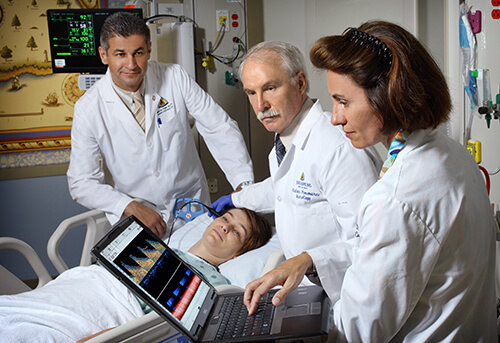About Transcranial Doppler (TCD)
An intracranial neurovascular exam is also known as a Transcranial Doppler (TCD) study. TCD is a non-invasive, painless ultrasound technique that uses high-frequency sound waves to measure the rate and direction of blood flow inside vessels. The test examines and records the speed of the blood flow in arteries known as the Circle of Willis, which are located at the base of the brain, to facilitate the diagnosis of a wide range of conditions affecting the brain following:
- Subarachnoid hemorrhage (SAH)
- Transient Ischemic Attack (TIA)
- Sickle Cell Anemia
- Embolism
- Cerebrovascular Accident (CVA)
- Cerebral Circulatory Arrest
While most different forms of ultrasonography make images of the tissue state studied, the TCD makes audible sounds that can be heard, recorded and examined.
Before the Procedure
There is no specific preparation necessary for this test. Patients do not need to change their diet or liquid intake prior to a TCD.
During the Procedure
 Team members from the Neurovascular Laboratory perform a Transcranial Doppler (TCD) test on a patient.
Team members from the Neurovascular Laboratory perform a Transcranial Doppler (TCD) test on a patient.The TCD is performed by a technologist trained in the specific type of neurovascular ultrasound. The patient will be awake and lying on a bed during the test. A small device called a transducer is connected to a laptop computer, which provides the technologist with data about the blood flow.
One or more transducers will be placed directly on the patient’s skin, with a small amount of gel facilitating the ultrasound. The technologist will apply the gel and transducer to the patient’s temples, base of the skull at the back of the neck area or on closed eyelids. The gel can be easily washed off after the test.
The technologist will change the transducer’s position to direct the ultrasound waves toward the blood vessels being examined. The patient will be able to hear the noise of blood flowing through the arteries from the ultrasound. A TCD can take between 30 minutes to 1 hour to complete.
